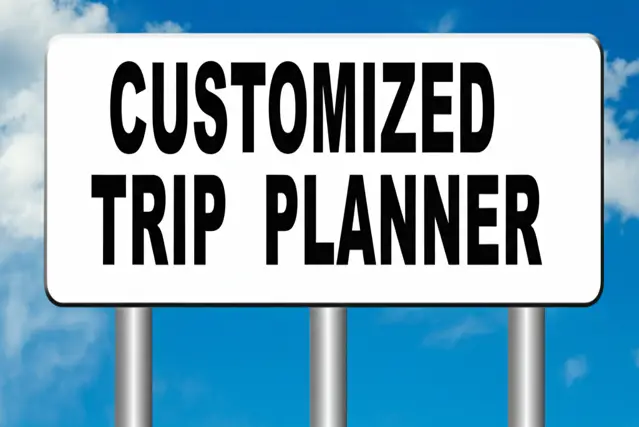Planning a vacation can be exciting, but it can also feel overwhelming. Where do you start? How do you ensure you’re making the most of your time and money? The answer lies in a customized trip planner. A well-crafted, personalized itinerary can transform a potentially stressful experience into a seamless and unforgettable adventure.
This comprehensive guide will walk you through every step of the process, from choosing the perfect destination to creating a detailed daily schedule, ensuring your next trip is your best one yet.
Table of Contents
Why Use a Customized Trip Planner?
In today’s world of readily available travel information, it’s tempting to simply book a flight and “wing it.” However, relying solely on spontaneity can lead to missed opportunities, wasted time, and unnecessary expenses. Here’s why a customized trip planner is essential:
- Maximizes Your Time: A planned itinerary ensures you see the sights that matter most to you without wasting precious vacation days.
- Saves You Money: By booking accommodations and activities in advance, you can often secure better deals and avoid last-minute price surges. Budgeting becomes easier and predictable.
- Reduces Stress: Knowing your schedule ahead of time allows you to relax and enjoy your trip without constantly worrying about what to do next.
- Tailored to Your Interests: A customized planner focuses on activities and attractions that align with your personal preferences, creating a truly unique and fulfilling experience.
- Uncovers Hidden Gems: Research and planning can reveal local favorites and off-the-beaten-path destinations you might otherwise miss.
Step 1: Defining Your Travel Goals and Preferences
Before you even think about destinations, it’s crucial to identify what you want to get out of your trip. This initial step forms the foundation of your customized itinerary. Ask yourself the following questions:
- What kind of experience are you seeking? Relaxation, adventure, cultural immersion, culinary exploration, or something else entirely?
- Who are you traveling with? A solo trip requires different planning than a family vacation or a romantic getaway.
- What is your budget? Be realistic about how much you can afford to spend on flights, accommodation, activities, and food.
- How much time do you have? A weekend trip will necessitate a different approach than a month-long adventure.
- What are your interests? Do you enjoy history, art, nature, food, or nightlife?
- What is your preferred travel style? Do you prefer luxury accommodations, budget-friendly hostels, or something in between? Are you comfortable with fast-paced travel, or do you prefer a more leisurely pace?
- What are your must-see attractions? Are there any specific landmarks, museums, or experiences you absolutely don’t want to miss?
Consider creating a mood board or brainstorming session to visualize your ideal trip. Write down all your ideas, no matter how far-fetched they may seem at first. This will serve as a valuable reference point as you begin to narrow down your options.
Step 2: Choosing Your Destination
Once you have a clear understanding of your travel goals and preferences, you can begin researching potential destinations. Consider the following factors:
- Climate: Research the weather conditions during your planned travel dates to ensure they align with your preferences.
- Accessibility: Consider the ease of getting to and around the destination, especially if you have mobility limitations.
- Safety: Check travel advisories and research crime rates to ensure your safety and security.
- Visa Requirements: Determine whether you need a visa to enter the country and allow ample time to apply for one.
- Local Culture: Learn about local customs, traditions, and etiquette to avoid cultural faux pas.
- Language: Consider the language spoken at your destination. Knowing basic phrases can enhance your experience.
- Cost of Travel: Research the average cost of accommodation, food, and activities to ensure it aligns with your budget.
Utilize online resources such as travel blogs, destination guides, and travel forums to gather information and inspiration. Read reviews from other travelers to get an unbiased perspective on different destinations. Consider using tools like Google Flights to explore flight costs to various locations.
Here’s a table showcasing some popular travel destinations and their suitability for different travel styles:
| Destination | Suitable For | Key Attractions | Average Daily Cost (USD) |
|---|---|---|---|
| Paris, France | Romantic getaways, cultural immersion, culinary exploration | Eiffel Tower, Louvre Museum, Notre Dame Cathedral, Seine River Cruise | $200 – $400 |
| Bali, Indonesia | Adventure travel, relaxation, budget travelers | Beaches, rice paddies, temples, surfing | $50 – $150 |
| Rome, Italy | History buffs, foodies, city explorers | Colosseum, Roman Forum, Vatican City, Trevi Fountain | $150 – $300 |
| Costa Rica | Nature lovers, adventure seekers, eco-tourism | Rainforests, beaches, volcanoes, wildlife | $75 – $200 |
| Kyoto, Japan | Cultural immersion, historical sites, gardens | Fushimi Inari Shrine, Kinkaku-ji (Golden Pavilion), Arashiyama Bamboo Grove | $150 – $350 |
Step 3: Researching Activities and Attractions
Once you’ve chosen your destination, it’s time to delve into the specific activities and attractions you want to experience. This step involves extensive research and careful prioritization. Consider the following:
- Identify Must-See Attractions: Research the most popular landmarks, museums, and historical sites in your destination.
- Explore Local Experiences: Look for unique activities that reflect the local culture, such as cooking classes, walking tours, or traditional performances.
- Consider Free Activities: Take advantage of free attractions like parks, beaches, and public art installations to save money.
- Read Reviews: Check online reviews on sites like TripAdvisor and Yelp to get an idea of the quality of different activities and attractions.
- Check Opening Hours and Admission Fees: Ensure the attractions you want to visit are open during your travel dates and budget for any admission fees.
- Book in Advance: For popular attractions, consider booking tickets in advance to avoid long lines and ensure availability.
Compile a list of potential activities and attractions, along with their costs, opening hours, and locations. Use a spreadsheet or a note-taking app to organize your research. Prioritize your list based on your interests and budget, identifying the “must-do” activities and the “nice-to-do” activities.
Step 4: Creating a Daily Itinerary
With your activities and attractions researched and prioritized, it’s time to create a detailed daily itinerary. This is where your customized trip planner truly takes shape. Consider the following tips:
- Start with the Essentials: Book your flights and accommodation first, as these are typically the most expensive and time-sensitive components of your trip.
- Allocate Time Wisely: Estimate how much time you’ll need for each activity, including travel time between locations. Be realistic about how much you can fit into a single day.
- Consider Travel Time: Factor in travel time between activities and attractions, especially if you’re using public transportation. Use online tools like Google Maps to estimate travel times.
- Build in Downtime: Don’t overschedule your itinerary. Leave room for relaxation, spontaneous exploration, and unexpected delays.
- Prioritize Activities: Schedule your “must-do” activities for the days when you’re most energetic and alert.
- Be Flexible: While it’s important to have a plan, be prepared to adjust your itinerary if necessary. Weather conditions, unexpected closures, or changes in your interests may require you to modify your schedule.
- Use a Trip Planning App: Consider using a trip planning app or website to organize your itinerary and keep track of your bookings.
Read More: Will A Wine Bottle Explode On An Airplane?
Here’s an example of a daily itinerary for a trip to Rome, Italy:
| Day | Time | Activity | Notes |
|---|---|---|---|
| Day 1 | Morning | Arrive in Rome, Check into Hotel | Take Leonardo Express train from FCO airport to Termini Station. |
| Afternoon | Colosseum & Roman Forum | Book tickets online in advance to avoid long lines. | |
| Evening | Dinner in Trastevere | Explore the charming streets and enjoy traditional Roman cuisine. | |
| Day 2 | Morning | Vatican City (St. Peter’s Basilica & Vatican Museums) | Book a guided tour to skip the lines and learn more about the history. |
| Afternoon | Castel Sant’Angelo | Enjoy panoramic views of Rome from the rooftop terrace. | |
| Evening | Cooking Class | Learn to prepare classic Italian dishes. | |
| Day 3 | Morning | Pantheon & Trevi Fountain | Visit these iconic landmarks early in the morning to avoid the crowds. |
| Afternoon | Borghese Gallery & Gardens | Book tickets well in advance as they sell out quickly. | |
| Evening | Farewell Dinner | Enjoy a final Roman meal at a restaurant with a view. |
Remember to be flexible and adapt your itinerary as needed. The most important thing is to enjoy your trip!
Step 5: Booking Flights and Accommodation
Once your itinerary is finalized, it’s time to book your flights and accommodation. This is a critical step, as it can significantly impact your overall budget and travel experience. Consider the following tips:
- Book in Advance: Flights and accommodation tend to be cheaper when booked well in advance, especially during peak season.
- Be Flexible with Dates: If possible, be flexible with your travel dates to take advantage of lower fares and room rates.
- Compare Prices: Use online travel aggregators like Skyscanner, Kayak, and Expedia to compare prices from different airlines and hotels.
- Consider Alternative Airports: Flying into smaller, less popular airports can sometimes save you money.
- Read Reviews: Before booking accommodation, read reviews from other travelers to get an idea of the quality and cleanliness of the property.
- Look for Deals and Discounts: Many hotels and airlines offer deals and discounts to members of their loyalty programs or to specific groups, such as students or seniors.
- Consider Alternative Accommodation Options: Explore alternative accommodation options like Airbnb, hostels, and guesthouses to save money.
- Check Cancellation Policies: Make sure you understand the cancellation policies of your flights and accommodation before booking.
Keep a record of all your booking confirmations and important contact information in a safe and accessible place. Consider using a travel app to store all your travel documents digitally.
Step 6: Planning Transportation Within Your Destination
Getting around your destination efficiently and cost-effectively is crucial for a smooth and enjoyable trip. Consider the following transportation options:
- Public Transportation: Utilize public transportation systems like buses, trains, subways, and trams to save money and avoid traffic congestion. Research the local public transportation system and purchase a travel pass if necessary.
- Walking: Walking is a great way to explore a city and discover hidden gems. Wear comfortable shoes and be prepared for long distances.
- Cycling: Many cities offer bike-sharing programs that allow you to rent a bicycle for a short period of time. This is a fun and eco-friendly way to get around.
- Taxis and Ride-Sharing Services: Taxis and ride-sharing services like Uber and Lyft can be convenient, but they can also be expensive. Be sure to agree on a fare before getting into a taxi.
- Rental Cars: Renting a car can be useful for exploring rural areas or destinations with limited public transportation. However, be aware of local traffic laws and parking regulations.
- Airport Transfers: Pre-book airport transfers to avoid the hassle of finding transportation upon arrival.
Research the different transportation options available in your destination and choose the ones that best suit your needs and budget. Download transportation apps to your phone for easy access to schedules and maps.
Step 7: Budgeting and Managing Your Finances
Creating a realistic budget is essential for avoiding overspending and ensuring you can afford all the activities and experiences you want to enjoy. Consider the following expenses:
- Flights: Factor in the cost of round-trip flights, including baggage fees.
- Accommodation: Estimate the cost of accommodation per night, including taxes and fees.
- Food: Budget for meals, snacks, and drinks. Consider the cost of eating out versus cooking your own meals.
- Activities and Attractions: Include the cost of admission fees, tours, and other activities.
- Transportation: Budget for transportation within your destination, including public transportation, taxis, and rental cars.
- Souvenirs: Set aside a budget for souvenirs and gifts.
- Travel Insurance: Purchase travel insurance to protect yourself against unexpected medical expenses, trip cancellations, and lost luggage.
- Miscellaneous Expenses: Allocate a buffer for unexpected expenses, such as laundry, tips, and emergency situations.
Track your spending throughout your trip to ensure you stay within your budget. Use a budgeting app or spreadsheet to monitor your expenses. Consider using a travel credit card that offers rewards points or cashback on travel purchases. Inform your bank and credit card company of your travel dates to avoid having your cards blocked.
Step 8: Packing Smart and Efficiently
Packing smart and efficiently can save you time, money, and stress. Consider the following tips:
- Make a Packing List: Create a detailed packing list to ensure you don’t forget anything important.
- Pack Light: Avoid overpacking by only bringing the essentials. Roll your clothes instead of folding them to save space.
- Choose Versatile Clothing: Select clothing items that can be mixed and matched to create different outfits.
- Bring Travel-Sized Toiletries: Use travel-sized toiletries to save space and comply with airline regulations.
- Pack a First-Aid Kit: Include essential medications, bandages, and pain relievers in a small first-aid kit.
- Bring a Universal Adapter: If you’re traveling internationally, bring a universal adapter to charge your electronic devices.
- Pack a Reusable Water Bottle: Stay hydrated by bringing a reusable water bottle.
- Wear Your Heaviest Items: Wear your heaviest shoes and jacket on the plane to save space in your luggage.
Check the weather forecast for your destination and pack accordingly. Leave some extra space in your luggage for souvenirs.
Step 9: Staying Safe and Healthy While Traveling
Your safety and health are paramount when traveling. Consider the following precautions:
- Research Local Laws and Customs: Be aware of local laws and customs to avoid unintentionally breaking the law or offending local residents.
- Make Copies of Important Documents: Make copies of your passport, driver’s license, and other important documents and store them separately from the originals.
- Share Your Itinerary: Share your itinerary with a trusted friend or family member so they know your whereabouts.
- Be Aware of Your Surroundings: Pay attention to your surroundings and avoid walking alone in unfamiliar areas at night.
- Protect Your Belongings: Keep your valuables secure and be aware of pickpockets. Use a money belt or a crossbody bag to keep your belongings close to your body.
- Drink Bottled Water: Avoid drinking tap water in countries where it is not safe.
- Eat at Reputable Restaurants: Choose restaurants with good hygiene practices to avoid food poisoning.
- Get Vaccinations: Consult with your doctor about recommended vaccinations for your destination.
- Purchase Travel Insurance: Travel insurance can cover medical expenses, trip cancellations, and lost luggage.
- Learn Basic First Aid: Knowing basic first aid can be helpful in emergency situations.
Be aware of potential scams and avoid situations that seem suspicious. Trust your instincts and don’t be afraid to ask for help if you need it.
Step 10: Enjoying Your Trip and Being Flexible
The most important part of planning a customized trip is to relax, enjoy the experience, and be open to new adventures. Remember that things don’t always go according to plan, so be prepared to be flexible and adapt to unexpected situations. Embrace the unexpected, try new things, and create memories that will last a lifetime.
- Be Open to Spontaneity: Don’t be afraid to deviate from your itinerary and explore new opportunities.
- Talk to Locals: Engage with local residents and learn about their culture and traditions.
- Try New Foods: Sample local cuisine and be adventurous with your food choices.
- Take Lots of Photos: Capture your memories by taking lots of photos and videos.
- Disconnect from Technology: Take some time to disconnect from technology and fully immerse yourself in the experience.
- Reflect on Your Experiences: Take some time each day to reflect on your experiences and appreciate the beauty of your surroundings.
- Be Respectful of Local Culture: Respect local customs and traditions.
- Leave No Trace: Be mindful of the environment and leave no trace behind.
Tools and Resources for Creating a Customized Trip Planner
Numerous online tools and resources can assist you in creating a customized trip planner. Here are some popular options:
- Google Maps: For navigation, finding points of interest, and estimating travel times.
- Google Flights: For finding the best deals on flights.
- Skyscanner: Another excellent flight comparison website.
- Kayak: For comparing prices on flights, hotels, and rental cars.
- TripAdvisor: For reading reviews of hotels, restaurants, and attractions.
- Lonely Planet: For destination guides and travel advice.
- Culture Trip: For discovering unique cultural experiences.
- Wanderlog: A popular collaborative trip planning tool.
- Trello: A versatile project management tool that can be used to organize your itinerary.
- Evernote: A note-taking app for storing travel information and ideas.
Advanced Customization Techniques
For those who want to take their trip planning to the next level, consider these advanced customization techniques:
- Theme-Based Itineraries: Design your itinerary around a specific theme, such as food, history, art, or adventure.
- Slow Travel: Spend more time in fewer places to truly immerse yourself in the local culture.
- Off-the-Beaten-Path Destinations: Explore lesser-known destinations to avoid the crowds and discover hidden gems.
- Volunteer Travel: Combine travel with volunteer work to make a positive impact on the local community.
- Sustainable Travel: Choose eco-friendly accommodation and activities to minimize your environmental impact.
- Personalized Recommendations: Use AI-powered travel planning tools to get personalized recommendations based on your interests and preferences.
Read More: Can You Bring A Steamer On A Plane? Know The Rules!
Common Mistakes to Avoid When Planning a Trip
Even with careful planning, it’s easy to make mistakes. Here are some common pitfalls to avoid:
- Overplanning: Don’t try to cram too much into your itinerary. Leave room for flexibility and spontaneity.
- Underestimating Travel Time: Factor in travel time between activities and attractions.
- Not Checking Visa Requirements: Ensure you have the necessary visas before traveling.
- Forgetting Travel Insurance: Purchase travel insurance to protect yourself against unexpected events.
- Not Budgeting Properly: Create a realistic budget and track your spending throughout your trip.
- Ignoring Local Customs: Be respectful of local customs and traditions.
- Not Packing Appropriately: Pack for the weather conditions and activities you’ll be doing.
- Not Informing Your Bank: Let your bank know about your travel plans to avoid having your cards blocked.
Frequently Asked Questions (FAQs) About Customized Trip Planners
Conclusion
Creating a customized trip planner is an investment of time and effort, but the rewards are immeasurable. By taking the time to thoughtfully plan your itinerary, you can ensure that your next trip is not only enjoyable but also deeply meaningful and aligned with your personal values. You’ll maximize your time, save money, reduce stress, and create memories that will last a lifetime. A personalized approach to travel planning can transform a generic vacation into a unique and enriching experience, catering specifically to your interests, preferences, and budget. This level of customization allows you to delve deeper into the culture, history, and natural beauty of your chosen destination, fostering a more profound connection with the places you visit.
The process of building a customized trip planner also fosters a sense of anticipation and excitement, making the journey begin long before you even step on a plane. The research and planning phases allow you to learn more about your destination and develop a deeper appreciation for its unique characteristics. You can discover hidden gems, uncover local secrets, and tailor your itinerary to reflect your passions and interests. This level of personalization elevates the travel experience from a passive observation to an active engagement, transforming you from a tourist into an explorer.
Moreover, a well-structured customized trip planner empowers you to make informed decisions and navigate unforeseen challenges with confidence. You’ll have a clear roadmap of your journey, allowing you to manage your time and resources effectively. This sense of control can significantly reduce stress and anxiety, enabling you to fully immerse yourself in the present moment and savor every aspect of your adventure. By proactively addressing potential issues and developing contingency plans, you can minimize disruptions and ensure a seamless and enjoyable travel experience. Ultimately, a customized trip planner is a powerful tool that empowers you to create the vacation of your dreams, transforming a potential source of stress into a catalyst for personal growth and unforgettable memories. So, embrace the journey, plan with intention, and let your customized trip planner be your guide to a truly extraordinary travel experience.
“`
Jewelry Dish Tray, Ring Dish, Ceramic Trinket Tray, Key Bowl, Decorative Plate, for Friends Sisters Daughter Mother (Milky White)
$5.99 (as of December 2, 2025 12:39 GMT +00:00 - More infoProduct prices and availability are accurate as of the date/time indicated and are subject to change. Any price and availability information displayed on [relevant Amazon Site(s), as applicable] at the time of purchase will apply to the purchase of this product.)Amazon Echo Show 5 (newest model), Smart display with Alexa+ Early Access, 2x the bass and clearer sound, Charcoal
$59.99 (as of December 2, 2025 10:01 GMT +00:00 - More infoProduct prices and availability are accurate as of the date/time indicated and are subject to change. Any price and availability information displayed on [relevant Amazon Site(s), as applicable] at the time of purchase will apply to the purchase of this product.)Bedsure Heated Blanket Throw Blanket - Fast Heating Electric Blanket, Soft Flannel Heated Throw with 4 Time Settings, 6 Heating Settings, Warm Gifts for Grandma & Grandpa & Seniors (50“x60”, Grey)
$42.99 (as of December 2, 2025 10:01 GMT +00:00 - More infoProduct prices and availability are accurate as of the date/time indicated and are subject to change. Any price and availability information displayed on [relevant Amazon Site(s), as applicable] at the time of purchase will apply to the purchase of this product.)Dreo Space Heater, Portable Electric Heaters for Indoor Use with Thermostat and Remote, 2024 Upgraded, Digital Display, 12H Timer, 5 Mode, 1500W PTC Ceramic Fast Safety Heat for Office Bedroom Home
$38.99 (as of December 2, 2025 10:01 GMT +00:00 - More infoProduct prices and availability are accurate as of the date/time indicated and are subject to change. Any price and availability information displayed on [relevant Amazon Site(s), as applicable] at the time of purchase will apply to the purchase of this product.)HydroJug Traveler - 40 oz Water Bottle with Handle & Flip Straw - Fits in Cup Holder, Leak Resistant Tumbler-Reusable Insulated Stainless Steel & Rubber Base - Gifts for Women & Men, Alumni Red
Now retrieving the price.
(as of December 2, 2025 10:01 GMT +00:00 - More infoProduct prices and availability are accurate as of the date/time indicated and are subject to change. Any price and availability information displayed on [relevant Amazon Site(s), as applicable] at the time of purchase will apply to the purchase of this product.)





